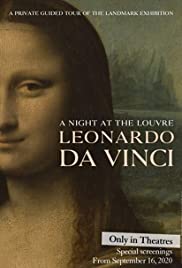
A NIGHT AT THE LOUVRE: LEONARDO DA VINCI
France, 2020, 90 minutes, Colour.
Directed by Pierre- Hubert Martin.
Some of us have had the privilege of visiting the Louvre in Paris. And most people know it is the home of da Vinci’s Mona Lisa. So, and invitation to spend a night at the Louvre is most welcome.
However, a word of caution is needed. Not exactly caution, but a clarification. This is not, as some might expect, a tour of the Louvre, moving from gallery to gallery, moving from painting to painting, absorbing the atmosphere of this enormous Art Museum.
Rather, this film is something of a Master Class. We are invited not only to look but also to listen, to the information provided by the guides, listening to a lesson, and then seeing how it is being illustrated. This is a Masterclass on the life, work and career, achievement of Leonardo da Vinci. A great number of sketches, artworks, diaries and notes have been gathered for building up this portrait of the artist.
Which means then that we learn the progress of da Vinci’s life, born in Florence, sent as an apprentice to an art school, artist, Andrea del Verrocchio as mentor, his ability with sketching, his introduction to painting, touches of sculpture. But we soon appreciate that da Vinci was not just an artist. He was also a scientist and mathematician. He was intrigued by mathematics. He was intrigued by geometry. His intellectual curiosity was not just in observation but in invention.
Light, shade, relief, energy and glow, tangible physical space, chiaroscuro, optics.
However, our guides insist that, for da Vinci, painting was the most important of arts and activities. It combined all his interests – and the value of this Master Class is that these theories are applied to several of da Vinci’s paintings, paintings of the Madonna to The Last Supper in the Dominican refectory in Milan.
This is also the kind of Master Class where the audience is tempted to take notes, reminders of the artist’s interests, his observations, his achievements. At one stage, the lecturers tell us that da Vinci wanted to “depict the imperceptible�. Eventually, moving from the special space devoted to the collection of items for the da Vinci exhibition, the guides and the camera, and we, travel up the staircases, through the galleries to see Mona Lisa enthroned. She is the theme of the last 15 minutes of the film, serving as a way of summarising the insights into the artist and his method and work, a close examination of the painting, its history, attempts at preservation, cleaning, but also suggestions on how he does depict the imperceptible.
Another quotation from our guides: for da Vinci “painting is a divine science that re-creates the world�.